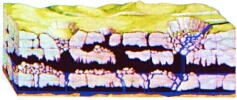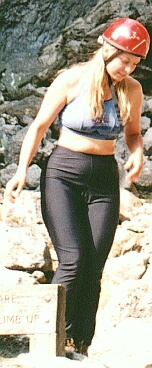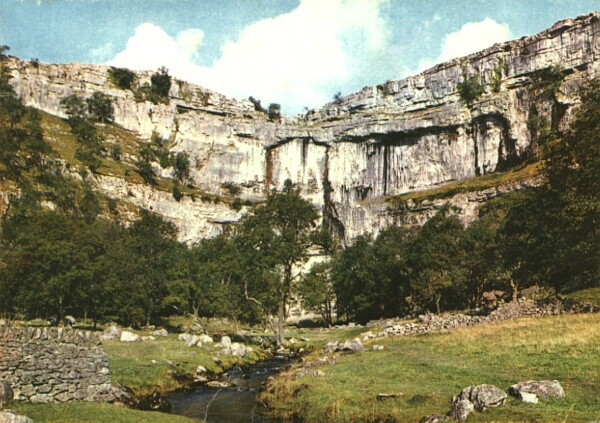 Limestone has a peculiar quality in that whilst pure water cannot dissolve it rain water can because it has picked up carbon dioxide from the air and soil and turns the limestone into calcium bicarbonate. That process of dissolving becomes in turn a process of placing calcium carbonate when the solution is deposited, either through evaporation or by impact.
Limestone has a peculiar quality in that whilst pure water cannot dissolve it rain water can because it has picked up carbon dioxide from the air and soil and turns the limestone into calcium bicarbonate. That process of dissolving becomes in turn a process of placing calcium carbonate when the solution is deposited, either through evaporation or by impact.
The actual dissolving happens along joints. Limestone is riven by joints (vertical) and bedding planes (horizontal). One the surface the joints are widened into grikes and the blocks left are called clints. There is a clints and grikes landscape above Malham Cove. Malham Cove itself is a large redundant waterfall because the water now goes underground through the limestone to emerge at the bottom, whereas once it flowed over the top.
|
|
|
Adrian went to Malham in 1976 for a sixth form Geography field trip and later has been with his mother twice since. It contains within a short area the redundant waterfall, the limestone paving of clints and grikes, Malham Tarn, Gordale Scar waterfall and Janet's Foss. However, there are no caves to visit here. This photograph is from a 1968 postcard which is probably when Adrian's mother went with other people.
|
The depositing happens inside already dissolving areas, particularly through drips and running trickles of water.
The water of course finds its way down from grikes, and some joints form sink-holes or swallow-holes. These can become vertical chimneys and horizontal galleries - caves.
There is some debate about the formation of caves. Some are just too big to be formed. So the theory is that the ground was higher and full of ground water. The water did its dissolving as it was moving around under pressure to springs. When the water table fell, the caves were left with just air in them. It is possible, of course, for the cave roof to fall in, producing rather large sink holes as the water tumbles in.

The water floods the upper bedding plane

Caves are formed and sinkholes drop

The water table has lowered
There is a whole architecture of limestone caves. Stalactites (the mites go up and the tites come down!) develop when the calcium bicarbonate containing water drips down joints in the cave roof. The drop hangs a little and can partially evaporate. With this, a tiny amount of calcium carbonate is deposited and a cascading effect is in motion. If the drop drips, of course, then either the partial evaporation or the splash on the floor causes stalagmites to grow (in this latter case looking like drips seen in slow motion, or stacks of saucers). In general, stalagmites are thicker than stalagtites, and stalagtites are thin, fragile and prone to break when too long. If lucky, therefore, the deposits from above and below may meet, producing a column.
This formation is not at the speed of light, but can be as slow as about one inch in 4,000 years although in Ingleborough Cave, three inches in in ten years is fast.
Stalagtites can also come from cave wall overhangs. All stalagtites can have finger formations called helictites. If water is running along a long crack in the roof, then the dripping takes place at several locations and a kind of fringe curtain results. A flowstone happens where water continually flows down a wall or along a floor. Gours occur when the rain water goes over an irregular surface so that the turbulent water produces a ridges pattern effect.
 There are other features too of the passageways. Streams, of course, always atempt to flow along at the lowest gallery. If the roof dips below the water level, and the stream contunues, then that is a siphon. This is when potholers are forced to go into the water. Where the floor dips there are pools. The streams can go through changes of levels, with internal waterfalls. The stream, of course, flowing on the bottom level, must be finding a way out of the hillside, otherwise it just develops deep pools.
There are other features too of the passageways. Streams, of course, always atempt to flow along at the lowest gallery. If the roof dips below the water level, and the stream contunues, then that is a siphon. This is when potholers are forced to go into the water. Where the floor dips there are pools. The streams can go through changes of levels, with internal waterfalls. The stream, of course, flowing on the bottom level, must be finding a way out of the hillside, otherwise it just develops deep pools.
The colours of a cave is determined by impurities, producing off white tendencies. Of course many a cave open to the public, like Stump Cross Caverns, near Pateley Bridge, used coloured lighting.
Early humans found caves to be ready made shelter, going deep into the rock. They often painted on walls. Bats have weak eyes and use their sonar systems to navigate. There are blind, colourless, almost transparent shrimps. There are worms, mites, insects and the newts often called blind fish that stay in the cave world. Blind white fish live in pools.
Some material using defunct Encyclopedia The Joy of Knowledge last published 1987 by Oriole
 Limestone has a peculiar quality in that whilst pure water cannot dissolve it rain water can because it has picked up carbon dioxide from the air and soil and turns the limestone into calcium bicarbonate. That process of dissolving becomes in turn a process of placing calcium carbonate when the solution is deposited, either through evaporation or by impact.
Limestone has a peculiar quality in that whilst pure water cannot dissolve it rain water can because it has picked up carbon dioxide from the air and soil and turns the limestone into calcium bicarbonate. That process of dissolving becomes in turn a process of placing calcium carbonate when the solution is deposited, either through evaporation or by impact.
 The water floods the upper bedding plane
The water floods the upper bedding plane Caves are formed and sinkholes drop
Caves are formed and sinkholes drop The water table has lowered
The water table has lowered
 There are other features too of the passageways. Streams, of course, always atempt to flow along at the lowest gallery. If the roof dips below the water level, and the stream contunues, then that is a siphon. This is when potholers are forced to go into the water. Where the floor dips there are pools. The streams can go through changes of levels, with internal waterfalls. The stream, of course, flowing on the bottom level, must be finding a way out of the hillside, otherwise it just develops deep pools.
There are other features too of the passageways. Streams, of course, always atempt to flow along at the lowest gallery. If the roof dips below the water level, and the stream contunues, then that is a siphon. This is when potholers are forced to go into the water. Where the floor dips there are pools. The streams can go through changes of levels, with internal waterfalls. The stream, of course, flowing on the bottom level, must be finding a way out of the hillside, otherwise it just develops deep pools.